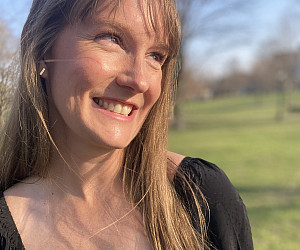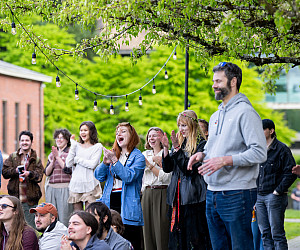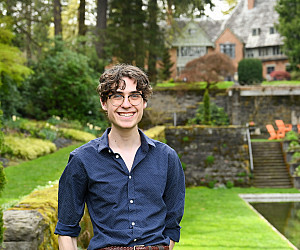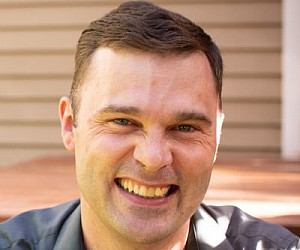main content Climate Action Plan Extends L&C’s “Green” Leadership

by Hanna Merzbach BA ’20
Lewis & Clark is in the first stages of updating its Climate Action Plan, with the goal of transitioning the campus toward a low-carbon, equitable future while maintaining the college’s position as a leading institution in the climate movement. The plan will emphasize educating future climate leaders and reducing the college’s carbon footprint to near zero by 2040.
This is an update to the 2008–09 Climate Action Plan, which the college developed after it signed on as a charter participant to the American College and University’s Presidents Climate Commitment. Under this plan, the college created a Renewable Energy Fee Fund, added an environmentally focused living learning community, among other curricular and cocurricular initiatives. The plan also emphasized reducing greenhouse gas emissions through energy efficiency, some renewables, and carbon offsets.
Since then, the college has committed to divesting its endowment from fossil fuels and reduced its exposure to publicly traded fossil fuel companies by over 50 percent. Now, according to Amy Dvorak, senior director of sustainability and communications, the college must do the same with its on-campus carbon footprint: “We must divest our facilities from fossil fuels like we have been divesting our endowment.” The updated plan will go a step further by putting equity and inclusion front and center and investing in new technologies to achieve carbon neutrality.
Making Facilities Carbon Neutral
On-campus operations make up the largest part of the college’s carbon footprint, so the plan will prioritize facility updates. These projects—which are the plan’s most time- and money-intensive—can be incorporated into the college’s current and future renovation plans.
According to David Ernevad, associate vice president for facilities, both Templeton Campus Center and the residential halls of Stewart and Odell will soon have “cutting-edge” heating and cooling systems. These systems will be energy efficient and help mitigate the impacts of climate change, such as increased heat waves and wildfire smoke.
“I believe we have an achievable, realistic, and well-thought-out road map reducing our carbon footprint to near zero by 2040,” Ernevad added.
The college’s strategy for going carbon neutral relies on Oregon eliminating carbon emissions from its power grid, which it plans to do by 2040. That’s why L&C is focusing on transitioning the campus to running on electricity, rather than natural gas.
“What we’re really looking to do is electrify as much of the campus as we can,” said Dvorak, explaining that much of the campus heating still relies on natural gas from the college’s central plant.
The updated Climate Action Plan will include a massive overhaul of the central plant boilers with a far more energy efficient system such as low-temperature hot water heating trading, heat pumps, and possibly geothermal elements. This would provide a path to campus-wide electrification along with some additional onsite renewables.
The college is currently studying the feasibility of this new central plant system, with the help of an $85,000 cash incentive from the Energy Trust of Oregon. According to Dvorak, results from this study are expected by late summer, with a target construction date starting in 2025.
The college plans to address other parts of its carbon footprint, like waste management, transportation, and commuting in the coming year. For example, maintenance and fleet vehicles will eventually be converted to electric.
So far, the L&C community has been enthusiastic about these climate initiatives—it’s just a matter of figuring out the logistics. According to Dvorak, “It’s more a question of how fast we can do it and how are we going to pay for it, rather than should we do it.”
Engaging Future Climate Leaders
Prior to the pandemic, on a 2019 incoming student survey, 85 percent of undergraduates indicated they had “a passion” or “considerable interest” in sustainability. In the same survey, students ranked climate change as the most important issue L&C should be acting on.
Engaging students, and the L&C community at large, will be essential for this Climate Action Plan, which will be paired with a variety of outreach opportunities, such as community meetings, classroom visits, and open houses. In addition to seeking broad feedback on the plan, the college hopes to educate the community on the very technologies it is investing in on campus, like energy-efficient devices, heat pumps, and solar technology.
“We’re trying to create educational opportunities that people can take into their own lives—or into other organizations or nonprofits that they work with,” Dvorak said.
On April 8, Dvorak will host the L&C Community Coffee Hour—an opportunity for employees from all three schools to learn more about the Climate Action Plan. During Earth Week, from April 16 to 22, the Office of Sustainability will host a number of educational and outreach events for the L&C community.
Contact Dvorak at advorak@lclark.edu to learn more about the Climate Action Plan.
More Stories

Write On
Poet Joins Elite Ranks of Guggenheim Fellows
Corey Van Landingham BA ’08 has been named a 2025 Guggenheim Fellow, one of the nation’s most prestigious awards for creative and intellectual achievement. The fellowship will underwrite a yearlong poetry project that explores how isolation can sharpen both perception and imagination.

Photo Essay
Festival of Scholars and Artists Celebrates Student Achievement
The annual Festival of Scholars and Artists returns for 2025 to celebrate the work of Lewis & Clark’s student body.

National Award
Finn Watson BA ’26 Wins Goldwater Scholarship
Watson is one of 441 students selected from a pool of more than 5,000 nationwide for the Barry Goldwater Scholarship, the preeminent award for undergraduates in the natural sciences, engineering, and mathematics.

New Leadership
Andrew Saultz Selected Dean of the Graduate School
Andrew Saultz, an alumnus of L&C’s Master of Arts in Teaching program, begins his tenure on August 4.
